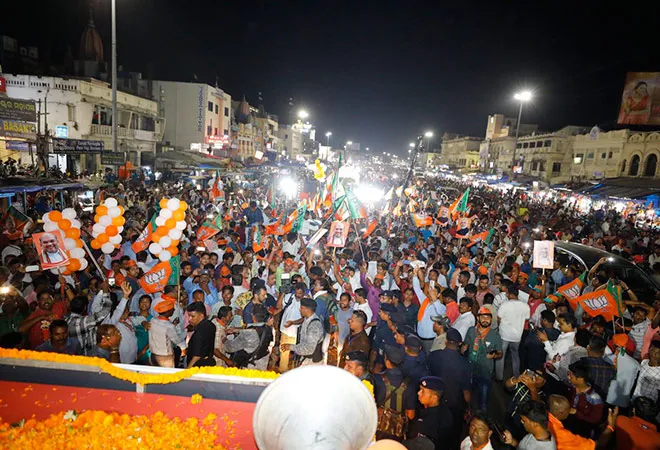-
CENTRES
Progammes & Centres
Location
The diversity of India's political set up means that no electoral majority is cast in stone and no ideological hegemony can enjoy the permanence.

This piece is part of the series, India @75: Assessing Key Institutions of Indian Democracy.
It is common knowledge that Indian democracy is undergoing a fundamental transformation. This has been marked by several changes including systemic ones in the nature of electoral competition, a multi-fold increase in the size of the middle class, penetration of social media, and the withering away of old hierarchies, amongst others. The social and geographical expansion of the Bharatiya Janata Party (BJP) since 2014, has altered the political landscape resulting in further marginalisation of the Congress, the decimation of the Left Front, and the decline in the strength of state-level parties. The BJP has made significant gains across the board, which has lessened the differences between various voting blocs curated in the past along with other social cleavages. Similarly, state-level specificities that dominated the discourse in the previous two decades, now have somewhat diminished status in electoral analyses, especially to understand the contours of national politics.
The BJP has made significant gains across the board, which has lessened the differences between various voting blocs curated in the past along with other social cleavages.
As India celebrates 75 years of independence, we assess the role of political parties in shaping the country’s democracy in this rapidly changing political landscape. Modern democracies are unimaginable without the political parties as they serve as the nerve centre linking citizens and the State in three critical domains—as channels of voicing individual grievances, vehicles of political ambitions, and platforms for interest groups to forge political settlements.
Political parties do have their own organisational life, but they are also nested in party systems. They are components or ‘parts’ of the system, and therefore, changes in the system naturally have repercussions on the parts. It is agreed that the party system in India has seen at least four transformations since the very inception. In the first-party system (1952-67), the Congress was the predominant party winning both at the national level and in most states, overshadowing other parties, thus famously described as the ‘Congress system’. The next phase was marked by the emergence of Opposition against the Congress party in several states, resulting in the polarisation of state party systems (1967-89). While the Congress continued to win nationally, the non-Congress opposition parties started winning larger proportion of seat and vote shares.
The current party system began with the formation of a single-party majority of the BJP in 2014. With a consecutive victory in 2019 and the party’s increasing presence, it was clear that India has entered in its second-dominant party system phase anchored around the BJP.
The third phase marked the beginning of the post-Congress polity—a competitive multi-party system (1989-2014) in which the Congress was no longer the dominant player nationally. The period witnessed the formation of coalition governments at the national level since no party could get a majority on its own. State-based parties acquired a greater voice both in the states and at the national level in this phase. The current party system began with the formation of a single-party majority of the BJP in 2014. With a consecutive victory in 2019 and the party’s increasing presence, it was clear that India has entered in its second-dominant party system phase anchored around the BJP. The median seems to have shifted so far towards the right that even the Opposition is either mute or coloured in strategy and tactics.
What is the ideological framework on which electoral contests in India are mounted? And how has contestation over “ideas of India” shaped the country’s political parties, party system, and democracy? Five broad trends could be observed:
India’s political parties act as platform for these societal forces, with a modest record—succeeding in some arenas while failing in others.
How must one understand the emerging contradictions in our polity: a robust competitive polity with state-level parties winning important assembly elections and active citizenry protesting on the streets, along with an ideological hegemony of the BJP? And, how should we explain the paradox that on one hand most political parties in India are decaying as organsations and showing centralising tendencies, yet playing crucial role in producing democratic outcomes such as representation of marginalised groups?
That the Indian democracy is sui generis. It is as much a by-product of institutional design as it is an accidental outcome of contradictory forces rooted in society. India’s political parties act as platform for these societal forces, with a modest record—succeeding in some arenas while failing in others. Their agility and adaptability have kept everyday politics energised. The routinisation of politics and entrepreneurial spirit of India’s politicians will act as a safety valve against any form of political culture acquiring hegemonic status. Furthermore, the civilizational diversity of India means that no electoral majority is cast in stone and no ideological hegemony can enjoy permanence. The continuous churn in India's diverse set-up will continue to produce opposing tendencies and ensure the democratic balance of our system.
The views expressed above belong to the author(s). ORF research and analyses now available on Telegram! Click here to access our curated content — blogs, longforms and interviews.

Rahul Verma is a Fellow at the Centre for Policy Research (CPR) and visiting assistant professor of political science at Ashoka University. His research interests ...
Read More +